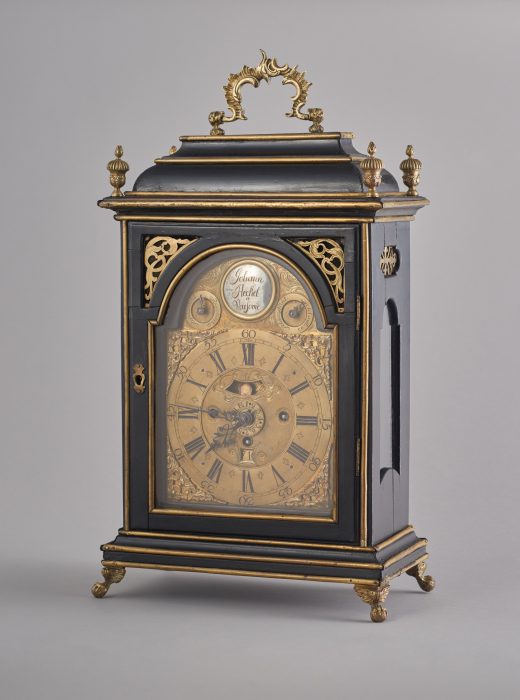
Bracket clock
Clock with a mechanism manufactured by Jan Heckel (d. before 1786) was produced approximately in the mid-18th century. It follows the type of British bracket clocks, whose rectangular cases usually had glass walls and domed-stepped top. The cases were often blackened to imitate precious ebony. They were adorned with applications and a handle was installed on top in order to facilitate transport. Such a clock form began to emerge after pendulum regulator had been introduced in horology by Christian Huygens (1629–1695). That innovation contributed to a greater precision in measuring time. Tall-case clocks of various shapes, equipped with a pendulum that maintained a constant oscillation frequency, were set on corbels, fireplaces and chests of drawers.
The name bracket clock comes from the wall brackets – corbels. Manufactured since approximately 1700, classic English bracket clocks were quick to gain popularity. They were produced on today’s territories of the Netherlands, Denmark, Sweden, Germany, Austria and the Czech Republic, among other areas. In the mid-18th century, they became a fashionable feature in wealthy houses in Poland. The presented bracket clock has a pendulum regulator, verge escapement, spring-driven movement, repeater, date indicator and alarm. The case was produced by anonymous craftsmen. Large glass panes offer an insight into the precise clockwork. Its heart is the regulator which registers fixed time intervals and an escapement that blocks and releases the switches of cogwheels to the rhythm of impulses delivered by the rhythmically moving pendulum. The upper part of the clock face contains two additional small clock faces that serve to switch on and off the mechanisms of alarm and striking. The latter offers the possibility to block the function of striking on the quarters of hours and hours, with which the clock is equipped.
The name of the maker of the mechanism and the place where it was manufactured is engraved on the top of the arch of the dial. In line with the fashion of the period, the name “Warsaw” is written in French. The name of the maker is given in the original German version – Johann Heckel, a native of Bavaria. A vast majority of clockmakers active in Warsaw in the second half of the 18th century had German origins. Jan was registered in the book of municipal rights of Old Warsaw in 1745. In 1756, he was a master of the horology guild. His professional life was linked with Warsaw. He died before 1786. Jan Heckel’s clocks are an extreme rarity. The Museum of Warsaw collection also includes a framed clock signed with his name.
Bracket clock
JAN HECKEL
WARSAW; BEFORE 1745
BRONZE, METAL, WOOD, CASTING, ENGRAVING, GILDING
MHW 29422/A–C
53,5 × 30,5 × 17,6 CM
Image licensed under: ![]()
